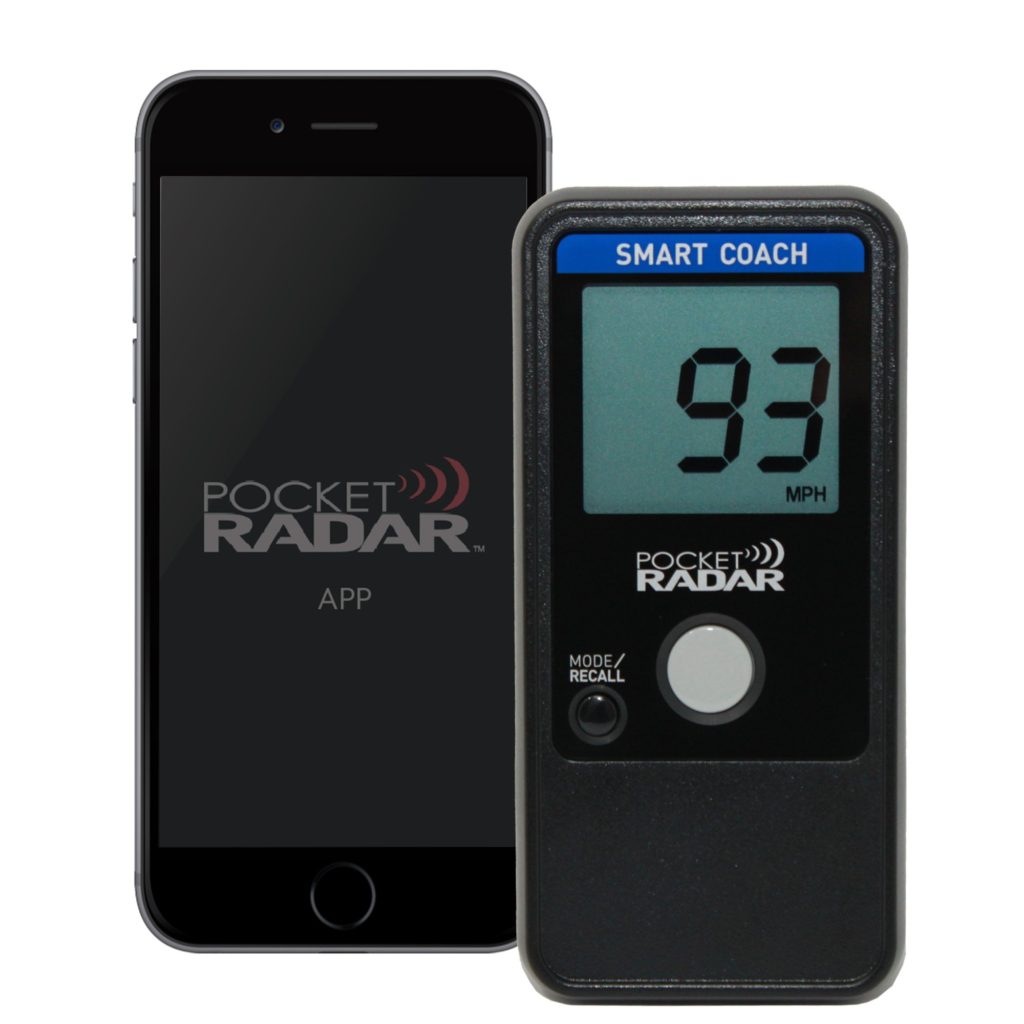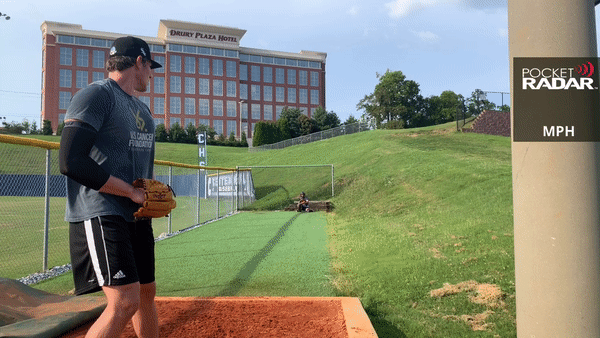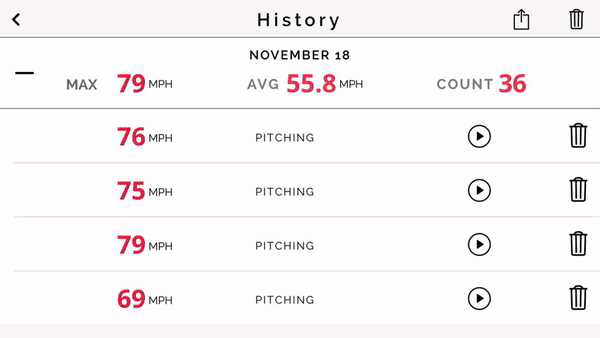The Pocket Radar Smart Coach
To improve something, measure it.
This simple rule guides our metric-driven approach, whether measuring strength, bar-speed, macronutrients, body composition, or velocity. So much so, that radar gun access is actually a requirement for athletes that train remotely with us.
The gold standard for baseball radar guns are still considered the Stalker Pro II ($1,199+) and the Stalker Sport 2 ($499+). We generally recommend the Sport 2 for coaches and athletes because it has no discernible difference in accuracy under normal training conditions.
We were excited to put the Smart Coach (listed at $399) through rigorous testing of our own, hopeful to be able to recommend a less expensive option to our athletes.
Design
The Pocket Radar is as compact as the name suggests. Measuring in at around the size of most cell phones, it’s much easier to carry around than the briefcase-sized Stalker Sport 2 carry case we also own. It comes with a clip-case, which I’ve found to be useful both for protection and for clipping to your belt or waistband.
Even without the case, though, the Smart Coach appears nearly indestructible. I’ve dropped it on turf, grass and even once on concrete without any issues besides a minor scuff (although I wouldn’t recommend testing this). Contrast this to the time I dropped my Stalker Sport 2 on concrete and spent 3 weeks waiting to have it recalibrated and repaired by Stalker after it began reading erratically.

The tradeoff here is that the Smart Coach lacks the typical barrel seen on other radar guns, affecting both the effective distance (rated to 120′ rather than the 300-500 feet for Stalker models*) and aiming of the device (imagine aiming a pistol that didn’t have a barrel – you’d have to be fairly close to ensure the right angle). Still, these drawbacks are negligible. For scouts, it still makes sense to stick to the clunky—albeit longer range—Stalker models.
*While I can actually pick up readings at 100-120 feet from a Pocket Radar, in my experience it’s nearly impossible to get readings with even a Stalker Pro II past about 200-250 feet, so these listed ranges are a bit exaggerated for practical purposes. With either gun, though, staying between 15 and 90 feet from ball release is a good guideline for accurate readings.
Design rating: 8/10
Accuracy
This is by far the most important aspect of any radar gun. I hesitate to put the Smart Coach in the “budget” radar gun category, as it’s more of a mid-range option. Still, it’s by far the least expensive option that can reliably hold its own against higher end models like the Stalker Pro II.
The Smart Coach does not display velocities to the nearest tenth like higher-end radar guns, but this is good enough for just about any trainee or coach, especially considering that even two Stalker guns will only read within about 0.5-1.0 mph of each other when placed side-by-side. The Smart Coach was consistently with +/- 1 mph of both the Stalker Pro II and Stalker Sport 2, which held for:
- 5 oz baseballs
- 3 to 32 oz Plyocare balls (both Driveline and Tap)
- 3 to 9 oz weighted balls (Driveline, Markwort, Prime and other brands)
- 2 to 8 lb medicine ball throws (note, the Ball Coach reads velocities from 25 to 130 mph, so medball throws below the threshold won’t read. Stalker guns can be set to pick up as low as 15 mph throws).
Below is some footage of the Ball Coach (a previous iteration of the Smart Coach) in action, compared to both a Stalker Pro II and a Sport 2:
Kyle, 14 oz TAP Plyocare – Pocket Radar vs. Stalker Pro II
Kyle bullpen – Pocket Radar vs. Stalker Sport 2
As you can see, it’s pretty accurate. A couple things to remember in order to get such consistent readings:
- Hold it very steady (we recommend using a tripod) and aim directly at release point.
- For manual readings, push the gray button a second or two prior to the pitch. If you push the button too late it may not pick up the pitch until it’s already half way to home plate, which will result in a slower reading.
- Stand between 15 and 90 feet from release point.
- Make sure the batteries are relatively fresh (I haven’t seen this screw up readings, but just do it to be safe).
For what it is (a mid-range training device), the Pocket Radar is as accurate as they come, and it’s the only mid-range or budget radar device I recommend to my athletes. While the inability to display tenths makes the Smart Coach more user friendly for lower-level athletes, it is the only reason I can’t give it a perfect rating on this section.
Accuracy rating: 8/10
Features
The Smart Coach offered a major upgrade from the Ball Coach (which was already a tool we reviewed quite favorably), adding compatibility with the Pocket Radar app. In addition to app (which we’ll go into later), it also has a lot of the essentials:
-
- Tripod compatible (must have a small attachment which can be purchased here or on amazon for a few bucks.
- Hold & Aim or Continuous Mode (the former conserves battery, while the latter is good for training solo).
- Runs on 2 AAA batteries (NiMH rechargeables will get up to 2 hours on automatic mode, and a couple thousand holds on regular mode).
- Range up to 120 feet.
- Measures from 25 to 130 mph speed to within +/- 1 mph.
- Can store and recall the most recent 25 readings (important when training solo and/or without the app).
- Can switch displayed units between MPH and KPH.
- Pocket Radar Smart Display LED board connectivity (Pocket Radar’s board is listed at $499, so using the Pocket Radar app on an iPad might be a more cost-effective way of mimicking a velo board, although this will likely prevent you from integrating the video feature during the session depending on your set-up).
Again, the most notable feature it doesn’t have is the ability to display to the nearest tenth of a mile per hour.
For more information, you can check out the full specifications at Pocket Radar’s website.
Features rating: 8/10
Pocket Radar App
The Pocket Radar app takes the Smart Coach to the next level. The app can be used to simply display velocities on your phone or iPad screen or to record video and stamp the velocity on each clip. Even when using the video function, the app offers the option to read out each velocity on your device, avoiding the need to constantly check each reading. Getting instant feedback—especially while training alone—is both helpful for high-output velocity days and as an auto-regulatory tool on low- or medium-intensity sessions.
Auto Edit Mode is an incredibly useful feature that automatically clips the video around each velocity reading. Each video is trimmed to 8 seconds, and includes 6 seconds pre- and 2 seconds post-reading to ensure the full delivery is captured.

Pocket Radar Auto Edit Clip
In addition to taking velocity readings and integrating the video feature, the Pocket Radar app also offers a “History” tab that houses each reading the gun takes, and organizes them all by day. On top of that, every reading’s video clip (assuming you utilize the Auto Edit Mode) is directly accessible next to its velocity. This is a huge tool that makes comparing footage incredibly easy, as you can immediately pull up the videos you want to investigate.

History Page with Video
Overall, the Pocket Radar app has been a game changer for a lot of our guys. In addition to its features, it is incredibly easy to use, and I’ve never had any issues connecting the Smart Coach to my phone within seconds.
App rating: 10/10
Value
Radar guns aren’t cheap, but the Smart Coach ($399) is the least expensive reliable radar gun on the market by over $100. For individual athletes or budget-conscious coaches, this is an excellent option. There really isn’t much else to say – it does exactly what it advertises, and comes in at a competitive price point. Especially with the addition of the Pocket Radar app, this Smart Coach is an incredible tool.
*The Pocket Radar Ball Coach is essentially the Smart Coach without app connectivity capability. Depending on your situation (whether you train solo, want integrated video, etc.), it might be another solid option, and is $200+ cheaper than the next reliable radar gun. In my opinion, though, the benefits of the Pocket Radar app justify the extra $100 price tag on the Smart Coach.
Value Rating: 10/10
Customer Service
We received our unit in 3 business days, and our email questions were all answered promptly (many of our athletes have reported similar experiences). We were also able to speak on the phone with their reps on a couple occasions to ask questions about the technology. Add to that a two-year warranty and Pocket Radar’s customer service has earned a thumbs up. Could it be better? I’m sure, but I can’t think of anything I would have changed.
Support rating: 9/10
Overall Thoughts
How sure are we of the Pocket Radar’s accuracy? Let’s put it this way – we’ve been accepting velocity submissions to our record board that were measured with both the Ball Coach and Smart Coach (not to mention the fact that a number of our athletes have been recruited off of their Pocket Radar app footage).
As a metric-driven company, devices like the Pocket Radar Smart Coach are critical to the sustained success of our athletes from a velo-building perspective. Instant feedback is vital to developing and engraining more efficient movement patterns to ultimately crack into the next tier of performance.
Is the Smart Coach perfect? No, but it does exactly what it advertises – and does it well. Higher-end users with the budget should still go Stalker (as brutal as their customer service and prices are), but just about everyone else will do perfectly fine with a Smart Coach.
To save 10% on a Pocket Radar Smart Coach, email us for a Coupon Code at contact@treadathletics.com
The Pocket Radar is available for purchase on Pocket Radar’s website.
